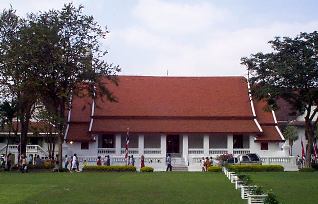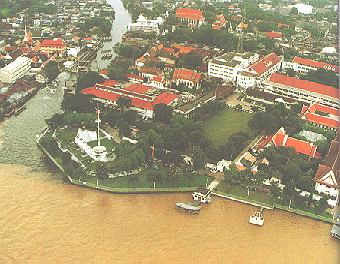|
Phra Raja Wang Derm, the offical residence of H.M. King Taksin the Great,
is situated on the west bank of the Chao Phraya River near Pak Klong Bangkok Yai, on the site of
H.M. King Narai the Great's Vichaiyen Fort.
H.M. King Taksin had the palace in 1767 after he had regained Thailand's independence and made Thonburi his capital. The Vichaiyen Fort was rebuilt and renamed
Vichaiprasit Fort. The site was considered to be of strategic importance as it was a strong fortress; a good observation and controlling post for both commercial and military purposes.
The boundaries of the Palace during H.M. King Taksin's time extended from the Vichaiprasit Fort to the canal north of Arun Rajawararam Temple
(Nakornban Canal) and included Wat Chaeng (Arun Rajawararam Temple) and Wat Tai Talad (Wat Molee Lokayaram) within its borders. Later, when
H.M. King Rama I ascended the throne, he moved the capital to Bangkok and built a new palace. The Palace of H.M. King Taksin the great then became known as
Phra Raja Wang Derm (the Original Palace). H.M. King Rama I later reduced the area of the palace by excluding the two temples from the palace grounds. Because of the palace's strategic location,
however, the King always had important members of the royal family residing there. This practice continued until H.M. King Rama V
gave the palace to the Royal Thai Navy to be used as the site of the Naval Academy.

A Thai style building and used as the Navy headquarters
Important members of the Royal family who resided at the palace were as follows Reign of
Rama I
Rama II
Rama III
Rama IV
Rama V
|
- H.R.H. Prince Krommaluang Tibetbodin 1782 to 1785
- H.R.H. Prince Krommaluang Isara Sunthorn 1785 to 1809
- H.R.H. Prince Krommaluang Pitakmontri 1811 to 1822
- H.R.H. Prince Mongkut 1823 to 1824
- H.R.H. Prince Krommaluang Isara Rangsan 1824 to 1851
- H.R.H. Prince Krommaluang Vongsathirajsnid 1851 to 1879
- H.R.H. Prince Kromma Phra Chakrapadibhongse 1881 to 1900
|
Three Kings were born at Phra Raja Wang Derm during the reign of H.M. King Rama I - H.M. King Rama III on March 31, 1787,
H.M. King Rama IV on October 18, 1804 and The Second King, Somdetch Phra Pinklao Chao Yuhua on September 12, 1808.
All of them were the sons of H.M. King Rama II while holding the title of H.R.H. Prince Krommaluang Isara Sunthorn.
After the death of H.R.H. Prince Kromma Phra Chakrapadibhongse, H.M. King Rama V graciously bestowed Phra Raja Wang Derm
to the Navy for use as the Naval Academy on February 23, 1900. His Majesty wished the Navy preserve and maintain the original structures, namely:-
the Throne Hall, the Abode of H.M. the Second King Phra Pinklao Chao Yuhua, the King Taksin Shrine and the Whale's Head Shrine.
The Navy which was still a department in those days, renovated and remodeled the palace for use as the Naval Academy headquarters, a school building and a dormitory.
When H.M. King Rama V officially inaugurated the Academy on 20 November, 1906 (Since then celebrated as Royal Thai Navy Day), he wrote in the visitor's book :-
"November 20, R.S. 125 (the 125th year of the Rattanakosin Period), I, Chulalongkorn have inaugurated this
school and am delighted to see naval affairs take root with the promise that it will become even more secure in the future."
The Naval Academy remained Phra Raja Wang Derm Until 1944 when it was moved terporarity to Sattahip during the Second World War. In 1946 the Academy moved to
Kledkeao before moving on to Samutprakarn in 1952.
The school building was remodeled into a Thai style building and used as the Navy headquarters and the Finance Department from 1949. At present, the building is used as the
Office of the Commander in Chief and the Naval Secretariat. Other units using the building include the Naval Education Department in 1943 (at present the Navy Administration Department).
In 1955 the Naval General Staff Department was abolished and the Naval Communications Department moved in.
The original buildings still remaining in the palace grounds are :-

Part of the Throne Hall of Phra Raja Wang Derm, December 27, 1998
| |





